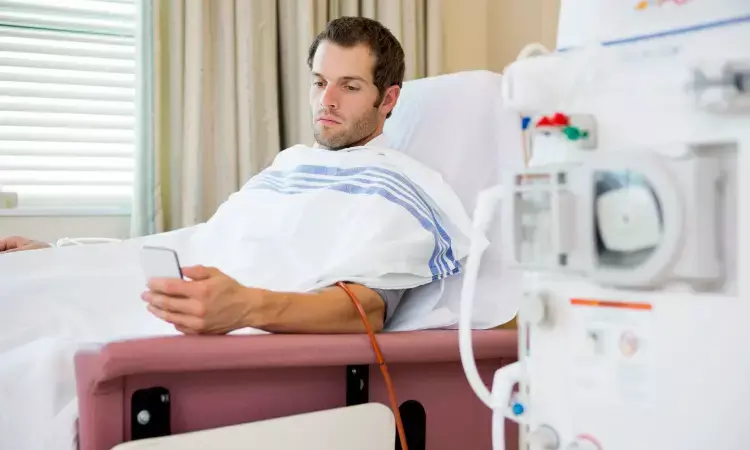- Home
- Medical news & Guidelines
- Anesthesiology
- Cardiology and CTVS
- Critical Care
- Dentistry
- Dermatology
- Diabetes and Endocrinology
- ENT
- Gastroenterology
- Medicine
- Nephrology
- Neurology
- Obstretics-Gynaecology
- Oncology
- Ophthalmology
- Orthopaedics
- Pediatrics-Neonatology
- Psychiatry
- Pulmonology
- Radiology
- Surgery
- Urology
- Laboratory Medicine
- Diet
- Nursing
- Paramedical
- Physiotherapy
- Health news
- Fact Check
- Bone Health Fact Check
- Brain Health Fact Check
- Cancer Related Fact Check
- Child Care Fact Check
- Dental and oral health fact check
- Diabetes and metabolic health fact check
- Diet and Nutrition Fact Check
- Eye and ENT Care Fact Check
- Fitness fact check
- Gut health fact check
- Heart health fact check
- Kidney health fact check
- Medical education fact check
- Men's health fact check
- Respiratory fact check
- Skin and hair care fact check
- Vaccine and Immunization fact check
- Women's health fact check
- AYUSH
- State News
- Andaman and Nicobar Islands
- Andhra Pradesh
- Arunachal Pradesh
- Assam
- Bihar
- Chandigarh
- Chattisgarh
- Dadra and Nagar Haveli
- Daman and Diu
- Delhi
- Goa
- Gujarat
- Haryana
- Himachal Pradesh
- Jammu & Kashmir
- Jharkhand
- Karnataka
- Kerala
- Ladakh
- Lakshadweep
- Madhya Pradesh
- Maharashtra
- Manipur
- Meghalaya
- Mizoram
- Nagaland
- Odisha
- Puducherry
- Punjab
- Rajasthan
- Sikkim
- Tamil Nadu
- Telangana
- Tripura
- Uttar Pradesh
- Uttrakhand
- West Bengal
- Medical Education
- Industry
Combining CRRT circuits with ECMO prolongs circuit life despite exposure to higher circuit pressures

Australia: New research published in Blood Purification: Critical Care Nephrology shows that combining continuous renal replacement therapy (CRRT) circuits with extracorporeal membrane oxygenation (ECMO) can result in a longer circuit life, despite exposure to higher circuit pressures.
The use of CRRT is common during ECMO and has specific technical characteristics which affect the circuit life. The researchers of the study aimed to assess CRRT hemodynamics and circuit life during ECMO.
The study compared ECMO and non-ECMO-CRRT treatments in two adult intensive care units over a 3-year period. A potential predictor of circuit survival was identified in a subset of data and subsequently assessed in the remaining data using a Cox proportional hazard model.
The study revealed the following clinical findings:
1. When CRRT circuits were used in conjunction with ECMO, the median circuit life was longer (28.8 hours) than when used alone (20.2 hours).
2. Access, return, prefilter, and effluent pressures were higher during ECMO, and higher ECMO flows were associated with higher access and return pressures.
3. High access pressures were identified as a predictor of an accelerated circuit failure in CRRT circuits used during ECMO, possibly due to progressive membrane thrombosis.
4. First access pressures ≥190 mm Hg and patient weight were independently associated with circuit failure.
5. Access dysfunction was associated with a stepwise increase in trans-filter pressure, suggesting a potential mechanism of membrane injury.
These findings have implications for the management of ECMO-CRRT patients, as clinicians may need to closely monitor access pressures and adjust ECMO flows accordingly to avoid circuit failure. The study also highlights the potential for membrane injury during ECMO-CRRT, indicating a need for further research into strategies to minimize this risk.
The lead author of the study Dr. B. Sansom said that “The study provides valuable insights into the hemodynamics and circuit life of CRRT during ECMO and underscores the importance of careful monitoring and management of these patients.”
Reference:
Sansom, B., Riley, B., Udy, A., Sriram, S., Presneill, J., & Bellomo, R. (2023, April 19). Continuous Renal Replacement Therapy during Extracorporeal Membrane Oxygenation: Circuit Haemodynamics and Circuit Failure. Continuous Renal Replacement Therapy During Extracorporeal Membrane Oxygenation: Circuit Haemodynamics and Circuit Failure Blood Purification - Karger Publishers; 2023 doi: https://doi.org/10.1159/000529928
Dr. Mahalakshmi Sivashankaran joined Medical Dialogues as an Intern in 2023. She is a BDS graduate from Manipal College of Dental Sciences, Mangalore Batch 2022, and worked as a Junior Resident at VMMC & Safdarjung Hospital at the Department of Dental Surgery till January 2023. She has completed a Diploma in Executive Healthcare management from the Loyola Institute of Business Administration, developing skills in Healthcare Management and Administration. She covers several medical specialties including Dental, ENT, Diagnostics, Pharmacology, Neurology, and Cardiology.
Dr Kamal Kant Kohli-MBBS, DTCD- a chest specialist with more than 30 years of practice and a flair for writing clinical articles, Dr Kamal Kant Kohli joined Medical Dialogues as a Chief Editor of Medical News. Besides writing articles, as an editor, he proofreads and verifies all the medical content published on Medical Dialogues including those coming from journals, studies,medical conferences,guidelines etc. Email: drkohli@medicaldialogues.in. Contact no. 011-43720751


